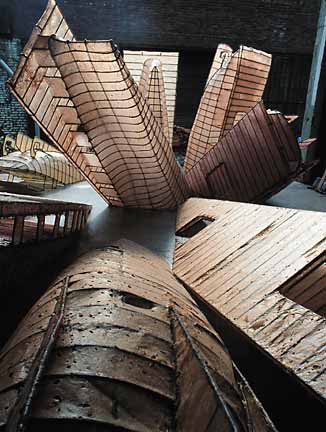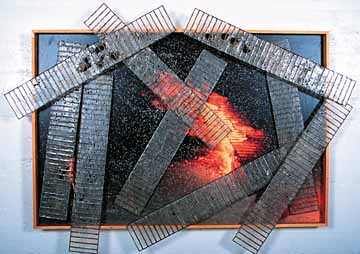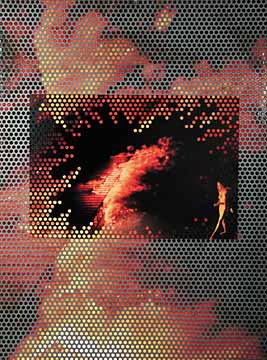
Current Issue Highlights More Readings DA Home About Direct Art
Rogues GalleryThe Work of Robert Reynolds
by Craig Stephens

Like the fruits of his artistic endeavor, Robert Reynolds in the flesh is equally as precocious and subversive. Its an uncharacteristically chilly afternoon in the Little Tokyo area of downtown LA and Reynolds is fittingly attired in Taliban regalia, complete with sandals and hat. As my shabby ride has just been booted, I’m without a car in LA -- an agonizing experience. Yet traveling in a shiny and majestic SUV, past the 99c and sportsgoods stores; piloted by a silver haired guy in a Taliban outfit seems to lift my mood -- it also puts me in a fitting mindset to ponder his artwork.
Robert or Reynolds, whichever you prefer, recently returned from Afghanistan, hence the new clothes. During his travels, he spent time observing and gathering information, passing the time with a posse of military luminaries and war correspondents. He also managed to acquire assorted wartime paraphernalia. His dining table boasts an ample collection of Taliban posters and t-shirts, he offers me one and I accept -- a warm reception.
His salubrious downtown studio/apartment is littered with the detritus of former glories and current passions. There’s scattered photographs, many from his latest trip, depicting a desolate landscape and desperate peasants hurrying to flee a billion dollar a day war. A frugal living area dominates one side, while the other stores assorted painting and drawings and the embryonic forms of various near-finished works. The floor is covered with various works in progress, including his sunken boat, sculpture series, fashioned from metal and fibreglass. A decidedly pop art styled piece, utilizing cereal boxes and neon signage is scattered nearby.
Reynold’s work occupies a range of media, from photography through to painting and sculpture. I see sculpture, multi media, painting and a successful melding of both each share healthy, varied themes; from a fascination with war and consumerism, to the analysis of corporate America and religion.

Having gained a degree in a non arts related subject, Reynolds has an entirely auto didactical approach when it comes to his art career. "I have always been fascinated by wartime, and things such as Germanic symbols." Reynold’s early work focused on assorted watercolors, with the first ten years of his career spent heavily inspired by the likes of John Singer Sargent and his portraiture. Asked to cite influences, Reynolds recalls Edward Hopper, Albert Ryder, and Ed Keinholz. "I also love the energy and textures of Anslem Keifer and Edward Hopper’s use of light," he muses.
"After dabbling heavily in watercolor work, I moved to heavily textural paintings, using oil paints, rice, straw and welded steel with resin which you can see in my ghost ship series." And who does he appreciate nowadays? Reynolds cites Mario Merz and his sculpture, Chuck Close, and his portraiture, Christo, Sidney Goodman, and Larissa Wilson.Removed from conventional notions of classicism and beauty, Reynolds’ work reflects the interplay of order and chaos through a paradoxical melding of popular icons.
Melding oil painting and neon lights, the work, "Marilyn in Auschwitz," beckons from Reynolds’ weighty portfolio. The painting serves as a metaphor for the controversial and even precocious nature of his work. The oil painting with neon sign attachment sees a cell lined with double bunks occupied with somber and emaciated Jewish refugees. The uniformed men stare blankly, while an iconic Marilyn Monroe is poised in the middle of the room in all her skirt raised glory. The work did manage to command voluminous complaints when hung in downtown LA gallery space, 410 Boyd Street. Many outraged observers claimed it was "artistic freedom used to rub salt into the wounds," another biliously exclaimed. "You are spitting at my grandfather."
Reynolds was keen to explain that the work is more a precocious jab at America’s unhealthy obsession with celebrity and pop culture, noting that the painting is based on a photograph taken when the then prisoners of war were being liberated. The painting is based on a 1945 photograph of slave laborers in the Buchenwald concentration camp, taken on the day of their liberation by the American army which would suggest appeasing any adverse reaction to the work or its shock value as something potentially damaging. Commenting on the work, and the ensuing controversy shrouding its display, a learned LA times journalist informed readers that it, "sums up the culture of celebrity worship that dominates, trivializes and obscures even the most heinous human acts."

In addition to his paintings, Reynolds dabbles heavily in sculpture, including a series of burning boats and aircraft carriers, with eight different pieces in all. The installation pieces consist of steel sculpted frames covered with resin Japanese rice paper that stretches over the steel like skin. Sunken ships and aircraft carriers make references to themes of violence and battle, serving as a memorandum to a forgotten era, a moment of sombre tragedy as they sink. The carriers are captured in poses that recreate a sinking or listing vessel; they are suspended in time, frozen as they sink into the ground. Frames range from 4 to 7 feet long seemingly scaled to fit the viewers imagination.
"I’ve always had a fascination for the destruction of man and the earth. This could translate as something as slow as rust on a sea freighter or the beauty of a ship’s final plunge into darkness, or the hypnotic site of a large aircraft, cartwheeling in slow gyrations towards the earth and the earth in turn shattered with debris."
Via the medium of photography, these works were in turn transferred to another dimension. After trucking them to a remote desert location, the replicas were set on fire and photographed while burning, creating an almost photodynamic quality, seeming to defy the constraints of their accepted dynamics. Post apocalyptic visions of the past are added via the addition of a lone female figure to the photograph. Illuminated in chiaroscuro, the figure recalls a Boticelli venus or possibly a nymph seducing the viewer into some kind of purifying ritual.
Another installation sees nest-like vessels constructed of wood and metal frames draped in wax. Use of layering and wrapping creates a complicated multi textured labyrinth of folds that help to suspend the work boats and birds set in resin based nest-like shapes.
Ultimately, Reynolds reaction to themes of war, consumer society and classification systems, abandons conventional notions of interior and exterior, conjuring an illusion that defies dimensional constraints. Here, ideas of protection and defensiveness from the outside world are synonymous with being imprisoned and suspended in time, deconstructing the authoritarian and allowing a broad perspective of an indimensional zone.
Robert Reynolds has shown largely in Californian galleries, including LACMA, Garry 4 and the Esterhazy Gallery. He is represented by Greg Mcgear Modern in Los Angeles.
Current Issue Highlights More Readings DA Home About Direct Art